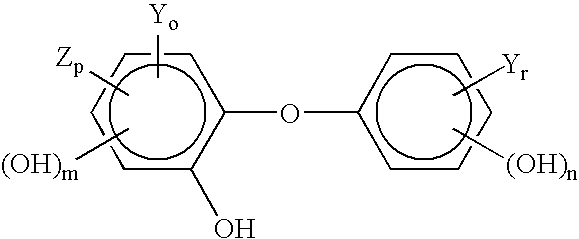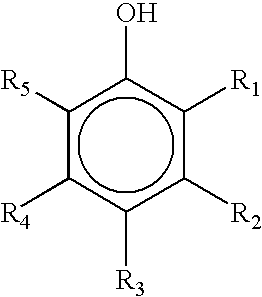Compositions Having a High Antiviral and Antibacterial Efficacy
a composition and antiviral technology, applied in the field of antiviral and antibacterial compositions, can solve the problems of high virus infection rate of all mammals, significantly reducing the population of microorganisms, including pathogens, and possible severe diseases in mammals
- Summary
- Abstract
- Description
- Claims
- Application Information
AI Technical Summary
Benefits of technology
Problems solved by technology
Method used
Image
Examples
example 1
[0161] A composition of the invention is prepared by admixing the following ingredients at the indicated weight percentages until homogeneous.
IngredientWeight PercentTriclosan (TCS)0.3Sodium lauryl sulfate0.75Ethanol65.0Sodium xylene sulfonate10.0Fragrance0.05Waterq.s.
[0162] The pH of the composition is about 3.5. The composition has a percent saturation of TCS of about 50%, and excellent antibacterial properties, exhibiting a greater than 1 log reduction in Gram positive and Gram negative bacteria in 30 seconds by the time kill test. The composition also eliminates human rhinovirus from the skin.
[0163] The antimicrobial compositions of the present invention have several practical end uses, including hand cleansers, mouthwashes, surgical scrubs, body splashes, antiseptics, disinfectants, hand sanitizer gels, deodorants, dental care additives, mouthwashes, and similar personal care products. Additional types of compositions include foamed compositions, such as creams, mousses, and...
PUM
| Property | Measurement | Unit |
|---|---|---|
| Fraction | aaaaa | aaaaa |
| Fraction | aaaaa | aaaaa |
| Fraction | aaaaa | aaaaa |
Abstract
Description
Claims
Application Information
 Login to View More
Login to View More - R&D
- Intellectual Property
- Life Sciences
- Materials
- Tech Scout
- Unparalleled Data Quality
- Higher Quality Content
- 60% Fewer Hallucinations
Browse by: Latest US Patents, China's latest patents, Technical Efficacy Thesaurus, Application Domain, Technology Topic, Popular Technical Reports.
© 2025 PatSnap. All rights reserved.Legal|Privacy policy|Modern Slavery Act Transparency Statement|Sitemap|About US| Contact US: help@patsnap.com



